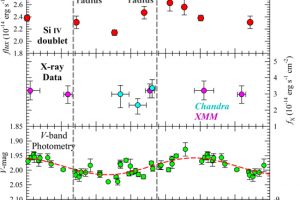The binary fraction in Cepheids revealed by X-ray observations. The paper: “X-Rays in Cepheids: Identifying Low-mass Companions of Intermediate-mass Stars” of N. R. Evans (SAO) recently appeared on ApJ

Cepheids are important stars for the well-known relation between the period of their pulsations and their intrinsic luminosities. These stars are in fact characterized by regular pulsations whose period increases linearly with their absolute magnitude. Cepheids have a mass of about 5 solar masses, thus their progenitors are B stars in Main Sequence. However, their evolutionary path can be affected by binarity.
Companions of cepheids are often characterized by means of spectroscopic observations in the UV. In this band, in fact, it is easier to distinguish the spectrum of the cepheids from that of their companions. However, this is strickly true when the companion is a hot star, with spectral class OBA. X-ray observations can be useful, instead, to characterize low-mass companions (spectral classes FGKM). Cepheids are in fact quite faint X-ray sources, while low mass stars can be a few orders of magnitude brighter.
In order to study the binarity in cepheids, 20 stars have recently been observed in X-rays. The paper: “X-Rays in Cepheids: Identifying Low-mass Companions of Intermediate-mass Stars” of N. R. Evans (Smithsonian Astrophysical Observatory) presents the observations of two stars of this class (Polaris and l Carinae), recently obtained with the NASA satellite Chandra, and the analysis of the whole sample. As expected, these two stars are not particularly bright in X-rays. The X-ray luminosity of Polaris is slightly higher than that of the Sun during the peak of its activity (about 6×1028 erg/s), while l Car is fainter. Besides, non of these stars is brighter in X-ray during the peak of their optical pulsation. From this survey, results that about 28% of the cepheids have a low-mass companion. Comparing this estimate with that of more massive companions (57%), it is possible to estimate the driving formation process for these systems, which in this case seems to be a combination of formation by fragmentation of a common circumbinary disk and capture of an indipendently-formed star. Among the coauthors, the astronomer I. Pillitteri of INAF – Astronomical Observatory of Palermo.
The figure (click here to visualize the entire image) shows the variability of Polaris in various optical bands: the intensity of the emission lines N v and Si iv, in X-rays, in the V band, and in radial velocity (periodic oscillations of the centroids of spectral lines due to Doppler effect).
Mario Giuseppe Guarcello ( follow mguarce) ( youtube)
Follow the Astronomical Observatory of Palermo on Facebok
Subscribe the Youtube channel of the Astronomical Observatory of Palermo
